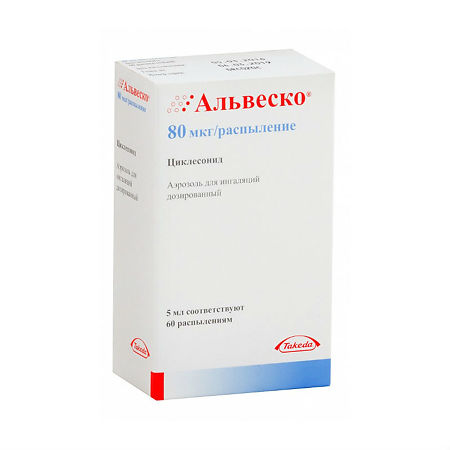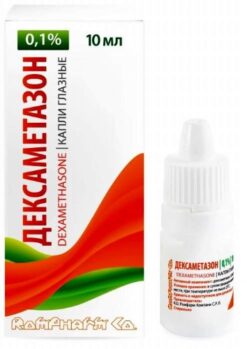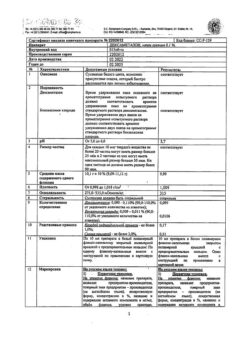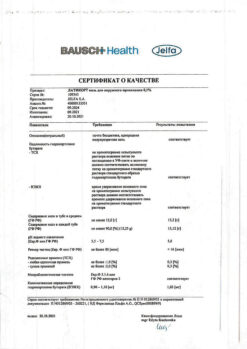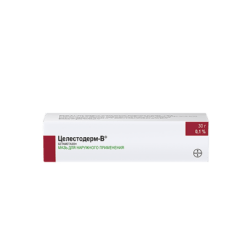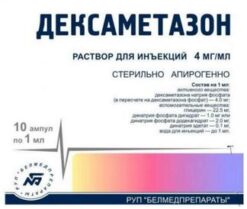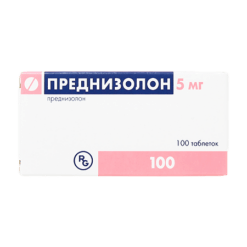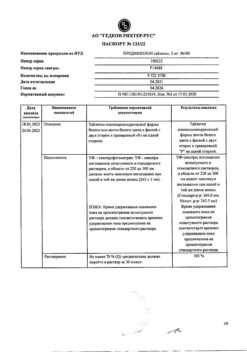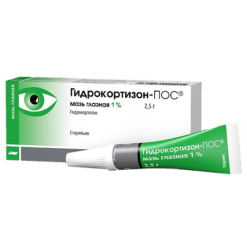Subtotal: €3.87
Alvesco, 80 mcg/dose aerosol, 60 doses
€1.00
Out of stock
(E-mail when Stock is available)
Alvesco is a GKS for topical application by inhalation.
Cyclisonide has low affinity for glucocorticoid receptors.
After inhalation, with the participation of enzymes, it is converted in the lungs to the main metabolite (desciclesonide, C21-desmethylpropionylcyclonide), which has pronounced anti-inflammatory activity and is therefore considered an active metabolite.
Ciclesonide suppresses inflammatory responses in the respiratory tract and thus alleviates bronchial asthma symptoms and improves lung function.
Indications
Bronchial asthma.
Pharmacological effect
Alvesco – GCS for local use in the form of inhalations.
Ciclesonide exhibits low affinity for glucocorticoid receptors.
After inhalation, with the participation of enzymes, it is converted in the lungs into the main metabolite (descyclesonide, C21-desmethylpropionylcyclesonide), which has pronounced anti-inflammatory activity and is therefore considered an active metabolite.
Ciclesonide suppresses inflammatory reactions in the airways and thus reduces the symptoms of bronchial asthma and improves lung function.
Special instructions
Alvesco is not indicated for the treatment of status asthmaticus or other acute episodes of asthma requiring intensive therapeutic measures.
The effect of inhaled corticosteroids during long-term use in children has not been fully elucidated. The doctor should constantly monitor the growth of children taking GCS for a long period. If growth slows down, therapy should be reconsidered in order to reduce the dose of inhaled corticosteroids. If possible, then to the lowest dose that maintains constant control of asthma symptoms. The dose of Alvesco may be reduced in patients requiring oral corticosteroids.
For patients switched from oral corticosteroid therapy to inhaled Alvesco treatment, decreased adrenal function may persist for a significant period of time after the transfer. The possibility of developing undesirable effects from the use of oral corticosteroids may persist for some time after their discontinuation. In such cases, it is recommended to monitor the reserve function of the adrenal cortex. The possibility of residual deterioration of the adrenocortical response in a critical situation (therapeutic or surgical) and in other individual cases that may be caused by a stress reaction should always be taken into account, as a result of which appropriate GCS treatment should be initiated.
In case of insufficient adrenocortical response or severe exacerbations, the dose of Alvesco should be increased; if necessary, oral corticosteroids should be used. In case of infection, antibiotics should be used. Paradoxical bronchospasm with increased wheezing and other symptoms of bronchoconstriction that appear immediately after inhalation should be treated with a fast-acting bronchodilator, which usually leads to rapid relief. The patient should be assessed and therapy with Alvesco should only be continued if, after careful consideration, the expected benefit is greater than the possible risk. The relationship between the severity of asthma and the general susceptibility to acute bronchial reactions should be taken into account.
Transfer of patients taking oral corticosteroids to Alvesco.
The transfer of patients treated with oral corticosteroids to Alvesco and their subsequent management requires attention, because restoration of reduced adrenal function caused by prolonged systematic corticosteroid therapy may take some time.
Patients taking systemic corticosteroids for a long period of time or at high doses may experience suppression of adrenal function. Adrenal function in these patients should be monitored regularly, and the dose of systemic corticosteroids should be reduced gradually. After approximately one week, gradual elimination of systemic corticosteroids can be started, reducing their daily dose by 1 mg of prednisolone or its equivalent. For maintenance doses of prednisolone above 10 mg daily, larger dose reductions over weekly intervals may be appropriate, cautiously undertaken.
Some patients may feel unwell during drug withdrawal, despite maintaining or even improving respiratory function. They should be evaluated for adrenocortical insufficiency.
When transferring patients from taking systemic corticosteroids to inhalation therapy, allergic reactions (for example, allergic rhinitis, eczema), which were previously suppressed by systemic drugs, may occur. These allergies should be treated symptomatically with antihistamines and/or topical agents, including topical corticosteroids.
Impact on the ability to drive a car or perform work that requires increased speed of physical and mental reactions. There is no data on the effect of the drug on the ability to drive vehicles and machines.
Drug interactions
According to in vitro data, CYP3A4 is the main enzyme involved in the metabolism of the active metabolite of ciclesonide – M1 (desciclesonide) in humans.
In drug interaction studies between ciclesonide and ketoconazole, as a strong CYP3A4 inhibitor, the effect on the active metabolite descyclesonide was increased approximately 3.5-fold, whereas no effect on ciclesonide was noted. Based on this, simultaneous use of potential CYP3A4 inhibitors and ciclesonide should be avoided.
An interaction study between ciclesonide and the CYP3A4 substrate erythromycin showed no interaction between them.
Active ingredient
Cyclesonide
Composition
1 dose contains ciclesonide 80 mcg.
Excipients:
norflurane (HFA-134a) – 54.46 mg,
ethanol – 4.74 mg.
Pregnancy
Controlled studies have not been conducted in pregnant women.
However, after inhaled administration of the drug, the concentration of ciclesonide in the blood serum is very low, therefore the effect on the embryo and potential toxicity affecting reproductive function are negligible.
The excretion of ciclesonide or its metabolites through breast milk has not been studied.
Like other inhaled corticosteroids, ciclesonide can be used during pregnancy and lactation as prescribed by a doctor if the expected therapeutic effect outweighs the risk of possible side effects.
Newborns from mothers treated with corticosteroids should be under medical supervision to rule out adrenal hypofunction.
Contraindications
hypersensitivity to the drug;
age up to 6 years.
With caution: patients with active or chronic pulmonary tuberculosis; patients with bacterial, viral or fungal infections of the respiratory tract.
Side Effects
In most cases, side effects were mild and did not require discontinuation of Alvesco.
– From the digestive system: sometimes (> 1/1000, 1/10,000, – From the respiratory system: sometimes – dyspnea, cough after inhalation, paradoxical bronchospasm.
– From the central nervous system: sometimes – headache.
– From the cardiovascular system: rarely – palpitations, arterial hypertension.
– Dermatological reactions: sometimes – eczema and skin rash.
– Allergic reactions: rarely – angioedema, hypersensitivity reactions.
– Local reactions: sometimes – reactions at the site of application, dryness at the site of application.
Other: sometimes – fungal infections of the oral cavity.
Inhaled corticosteroids can cause systemic effects, especially with long-term use in high doses.
Interaction
CYP3A4 is the main enzyme involved in the metabolism of the active metabolite of ciclesonide, M1 (desciclesonide).
In drug interaction studies between ciclesonide and ketoconazole, as a strong CYP3A4 inhibitor, the effect on the active metabolite descyclesonide was increased approximately 3.5-fold, while no effect on ciclesonide was noted. Based on this, simultaneous use of potential CYP3A4 inhibitors and ciclesonide should be avoided until the benefit outweighs the possible risk of systemic side effects of GCS.
An interaction study between ciclesonide and the CYP3A4 substrate erythromycin showed no interactions between them.
Overdose
Acute overdose
Symptoms: Inhalation administration of a single dose of 2880 mcg of ciclesonide was well tolerated in healthy volunteers. The potential for acute toxic effects following an overdose of inhaled ciclesonide is low. There may be increased dryness of the mucous membrane of the mouth and pharynx, a feeling of irritation or sore throat, and dysphonia.
Treatment: after an acute overdose, there is no need for specific treatment.
Chronic overdose
Symptoms: After chronic administration of 1280 mcg of ciclesonide, no clinical signs of adrenal suppression were observed. However, if exceeding the recommended dose continues for an extremely long period of time, some degree of adrenal suppression cannot be ruled out.
Treatment: It is recommended to monitor adrenal function.
Storage conditions
In a place protected from light, at a temperature not exceeding 30 °C
Shelf life
3 years
Manufacturer
Takeda GmbH, Germany
| Shelf life | 3 years |
|---|---|
| Conditions of storage | In a light-protected place, at a temperature not exceeding 30 °C |
| Manufacturer | Takeda GmbH, Germany |
| Medication form | inhalation aerosol |
| Brand | Takeda GmbH |
Related products
Buy Alvesco, 80 mcg/dose aerosol, 60 doses with delivery to USA, UK, Europe and over 120 other countries.


